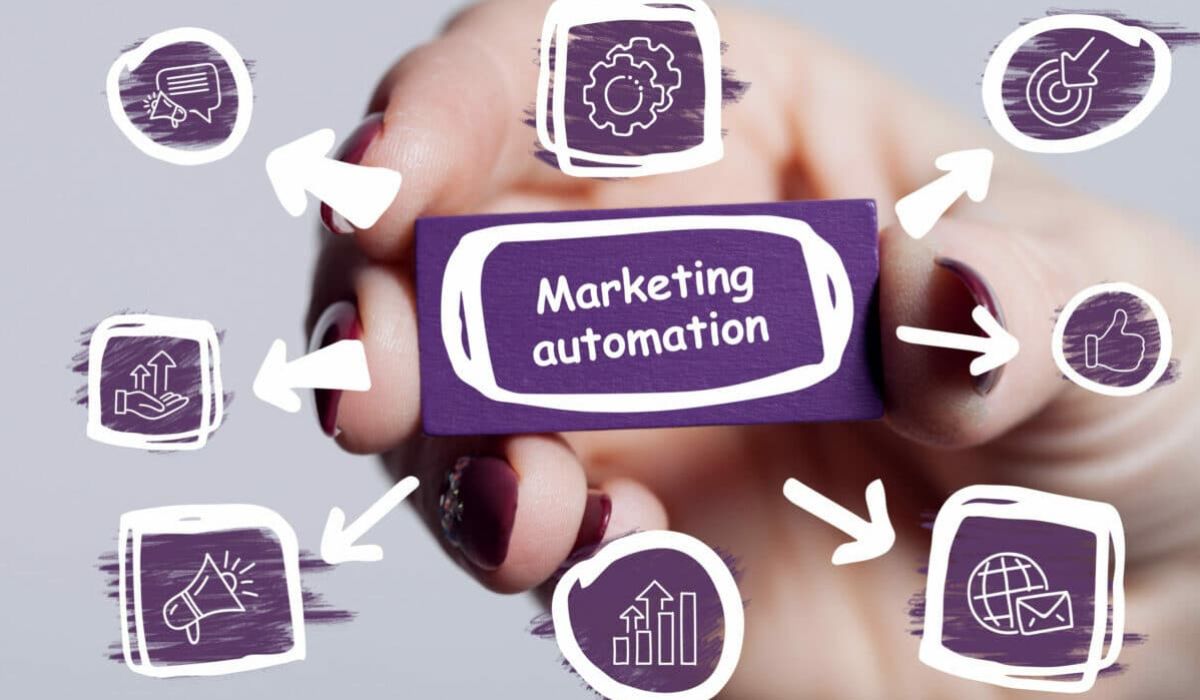Marketing automation examples: Best practices and best uses

Marketing automation at first may sound like a little intimidating concept but its basic principle is very straightforward. All you need to do is to create simple automated workflows to hit your potential or real customers at the right time.
Once set up, these automated workflows will do the rest of the job for you. According to Marketo, 76% of marketers using automated marketing campaigns experience positive ROI within one year.
You can use marketing automation for your business at multiple stages but it requires a strategy to do it well. First, you’ll need to identify the workflows that you not only can automate, but you also need to make sure that your automated operations generate the best possible results in the shortest possible time.
There are countless marketing automation tools available in the market that you can use for different purposes. In this article, we’ll discuss the best marketing automation examples along with the most suitable tools that you can use to maximize your b2b business’s ROI. So, without any further ado, let’s dive into it.
Shall we?
Marketing automation examples that you can start using today
Marketing automation refers to the practice of using software solutions and tools to automate marketing workflows based on your defined triggers. As compared to traditional email campaigns that a company usually sends to the whole list, automation allows you to create multiple campaigns with personalized and promotional emails that are sent to a specific list.
Marketing automation is a great way to engage with each customer differently based on his/her needs. It’s a powerful technique to streamline the marketing campaigns that will allow you to hit the right person at the right time.
If you’re not using the power of automation for your business’s marketing strategy, then you’re missing out on a lot of potential customers. Keep in mind that marketing automation is behind the success of about 80% of marketers worldwide. Here are 12 different ways they can integrate marketing automation into their department.
Automate customer messaging
It might sound a bit surprising, but marketing automation actually saves your money in the long run. According to Zapier stats, 33% of marketers say that automation allows them to achieve more by spending fewer resources.
Perhaps the most important part of marketing automation is your customer messaging. You should automate as many email campaigns as possible not only to save time but also to save your marketing budget.
1) Newsletters
Automating newsletters simply means sending newsletters without doing manual work. In order to automate your company’s newsletter campaigns, you’ll need to identify your customers’ behaviors and activities.
You can achieve it in two different ways if you want to use marketing automation.
· Trigger emailing: It means you’ll send emails to specific leads based on their behavior (triggers).
· Lifecycle emailing: In this technique, you send newsletters to your customers at strategic points throughout their lifecycle or journey.
Using these two techniques you can personalize your emails down to the tiniest details. You can also send personalized content to the customers at the most relevant time. Whatever you do, your email campaigns must have the following traits.
· Timely Automation: Your newsletter emails will be automatic that’ll save a lot of time but it must also be timely. It means your customers must get the content and promotions when it’s most relevant to them.
· Scalable Automation: Your email automation must also be scalable so that you can manage more people/subscribers.
You don’t really need to start with advanced segmentation or a bunch of different moving parts because it’s not very difficult to become overwhelmed. Start with a couple of campaigns and try to learn from them. Using RASA.io is a great way to start your newsletter automation journey.
2)Customer onboarding
When a customer tries or buys your services or product, you should have an automated communication flow in place. You can follow the steps mentioned below to deal with each customer efficiently.
3)Welcome email
You would have already heard that the first impression is the last impression. Even if you don’t buy it, still the first impressions are very important. However, in this era, it’s not feasible to stare at your subscriber count and curate an email to send them when it reaches a specific threshold.
Your welcome email campaign is meant to give each new subscriber an instant hello. In this email you can:
- Inform your new subscribers what should they do next
- How to use your service/product efficiently.
- Offer platform updates
You want to make sure that each new subscriber feels special and that you respect and value him/her. You can achieve it by using SendGrid but you’ll need to attach your application with it.
Automate customer service
If you want to enhance your customer experience, then automation has got that covered as well. All you need to do is to use the right marketing automation solution and offer the service that your customers need. You can use the following techniques to achieve it.
1)Chatbot
Adding a chatbot on your website based on AI is a must because it can provide you with much higher engagement than you can imagine. It’ll allow you to manage the queries of your customers outside business hours. You can use ManyChat or Tidio for this purpose.
2)Product Returns
Depending upon the types of product you offer, you can also automate your product return workflow. You can use Zenaton that can be integrated with Trustpilot, Zendesk, SendGrid, and Chronopost. It automatically sends important information to the customers about each product return and keeps the customers updated about the status.
3)Transactional messages
Transactional messages or emails aren’t sent to a group of people. Instead, they’re only triggered when a customer buys something from your website.
For example:
- Send a confirmation email if a customer buys something
- Send a notification email when the status changes
- Send an email
You can use Customer.io to automate your transactional messages.
4) Cart abandonment
Cart recovery emails are one of the best marketing automation workflow examples to get shoppers back. Keep in mind that many people are interrupted constantly while shopping online and they forget where they left.
According to MooSend, 45% of people open the cart abandonment emails, and 10.7 percent of them complete their buying process. That’s why your marketing automation platform should automatically send an email the next day if a cart is abandoned.
5) Customer feedback/reviews
Customer reviews
Automating email campaigns for customer feedback also comes in handy and allows you to earn more reviews. According to TrustPilot, 89% of people read online reviews before buying any product. If a customer buys something from you, then your marketing automation strategy should send him/her an email asking to share their experience by showing your appreciation.
Customer feedback
You can also use a customer or website feedback tool to encourage your visitors to offer feedback like reporting bugs and requests for new features. You can find many customer feedback automation tools available in the market. Not only do they allow you to collect customer feedback but you can use them to perform announcements and roadmap management.
Frill.co is a great choice that you can use to:
- Update your website visitors automatically who suggested a new feature, reported a bug, or upvoted any submission by other users.
- Send automatic updates to specific customers when their suggested features are deployed or reported bugs are fixed.
It’s a great way to keep your website updated and inform your visitors that you value their thoughts at the same time.
Automate marketing tasks
1) Lead Scoring
Manual lead scoring is almost impossible as you need to rate each lead based on its actions. You might already have tens of millions of total leads so it’s better to use an automation tool. You can use the lead scoring tool by Journeys Autopilot App.
It allows you to perform the following:
- Automatically tally up the interactions of each of your website visitors and give a score based on his/her activity.
- Allows you to download all the gated content pieces against each lead collected from different sources such as your online forms.
Based on the scoring you can put each lead into a different campaign to offer a personalized customer experience. You can also try the demo of the aforementioned software for free to make sure whether it’s the right option for you or not.
2) Lead nurturing
After lead scoring, you’ll also need to cultivate your relationship with your customers and that’s where the concept of lead nurturing comes into place. The main goal of lead nurturing is to keep your audience engaged all the time. In order to nurture your leads, you’ll need to offer content or information to your users based on their needs.
You can use UTM codes and tracking cookies to keep track of what content and platform they interact with the most and automate the lead nurturing campaigns that are personalized to the current stage in the marketing funnel.
- Send them automated emails with relevant blog posts or industry news
- Keep them updated on your latest marketing campaign and the promotions that could save them money
- Send personalized emails for each webinar you create
3) Posting on social media
Modern marketing automation systems also allow you to automate your social media posting. It’s one of the great examples of marketing automation that you can use to update your customers, provide them with the most relevant content, and bring them to your website to buy your products/services using actionable links.
You can use tools like ConstantContact or SocialBee to automate the posting across all social media accounts.
4) Automate marketing analytics
You would also want to use b2b marketing automation tools that allow you to automate marketing analytics. There are plenty of tools such as Whatagraph available in the market that you can use to create customized analytics reports.
These reports will provide you with valuable insights to find your strengths and weaknesses to bring necessary changes in your marketing strategy. For example, automating marketing analytics allow you to:
- Track most important KPIs (Key Performance Indicators) such as churn rate, retention rate, revenue growth, profitability over time, working capital, new leads, repeat customers, and much more.
- These KPIs allow you to understand your customers deeply to provide the experience they need to improve your business.
- You can check vital data points within a matter of seconds that may take a lot of time to find manually.
5) Automate your reward program
Starting a reward program is a great way to attract more customers and improve your customer’s retention rate. But managing it can be a hassle. Therefore, consider automating your entire reward system as well.
For example, you can offer a free voucher to a customer who placed the highest number of orders within a month. You can also offer a free giveaway on referrals. You can automate the whole functionality very easily by using a reward program automation tool like Smile.io that can:
- Give rewards automatically
- Allow the customer to redeem rewards
- Gives points to customers against specific actions or purchases.
6) Cold outreach campaigns
Cold outreach marketing campaigns are the first thing that most businesses do to grab the attention of their potential customers. You really don’t need to perform this workflow manually. That’s because there are tools out there that create marketing automation workflows so they can do the work for you.
Mailshake is a great example of a marketing automation tool that you can use for this purpose. All you need to do is to create highly personalized messages, upload the contacts you would like to reach out to and it will take care of the rest. It can send emails to hundreds of your prospects at once.
The benefit to this type of automation really shows when you need to send follow-up emails. With conditional logic, you can send additional emails based on how they respond, or if they respond at all. This can all be done without you having to do it manually.
When should you use marketing automation for your business?
As you can see, marketing automation can be used in a myriad of different strategies. It can also be applied to most types of businesses and you should use it for:
- Repetitive tasks such as reporting, email responding, and social media posting will only consume a whole lot of time if done manually.
- The tasks that aren’t possible to perform manually such as lead scoring.
Basically, you should start using automation tools when it can save you time, money, or both. It also provides your teams with more time to spend on more critical tasks such as improving the overall marketing strategy.


